Filling large holes in solid walls
For filling large holes, and damaged areas, in solid walls (masonry), you need to patch plaster. Plastering on any scale is a messy job so make sure that you use dust sheets to protect surrounding surfaces. If you choose to mix up your own plaster, rather than use ready-mixed, make sure that your buckets are spotlessly clean, and never use out of date plaster as it will harden too quickly making it impossible to smooth.
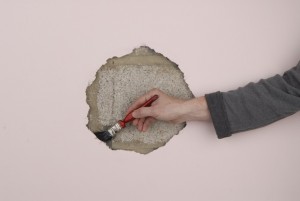 |
1. Use an old paintbrush or dusting brush to remove any loose debris from the damaged area. Pay particular attention to the edges and ensure the area is as dust free as possible. |
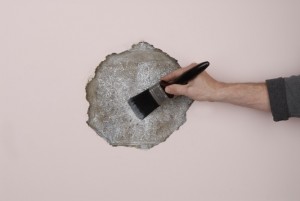 |
2. To ensure a good bond for the new plaster, brush the area paying particular attention to the edges with a 5:1 PVA solution (5 parts water to 1 part PVA). |
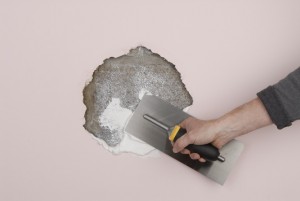 |
3. Apply some plaster to the hole – in this case a ready-mixed one-coat plaster has been used. You can mix your own, in a bucket, if you prefer. Do not put too much plaster on the plastering trowel, but press it firmly in place. |
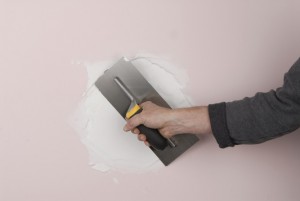 |
4. Smooth the plaster roughly level with the surrounding wall surface and leave for half an hour, or until it starts to go off/set. |
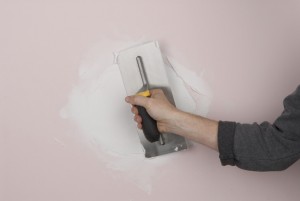 |
5. Smooth the area once more, trying to get as smooth a finish as possible, which is level with the surrounding wall surface. Sand when dry. |
Tips for filling holes in walls
- Depending on the depth of the hole, you may need to build up coats of plaster gradually. A one-coat plaster as shown here can generally fill a 1cm depth in one coat, but any more than that and you should look to do the job in more than a single application.
- Keeping tools clean is vital to get a good finish. Keep a bucket of clean water handy and clean the blade of the plastering trowel often.
- If an old plaster wall has a number of damaged or unstable areas, it may be best to remove all the old plaster and start again. The wall will need to be rendered before plaster is applied, and unless you DIY plastering skills are excellent, some professional help will be required.
- In older properties walls may be constructed of traditional lath and lime plaster. Repairs can be made using similar techniques to that shown above, but it is essential to get the plaster to bind well to the laths, so ensure that they are dust free and use at least one coat of a PVA solution to create a good bond. If the laths are very wide apart or themselves damaged, you can try screwing some fine wire mesh to the hole that will provide a good base for the application of plaster.
- In listed buildings, repairs to old lath and plaster walls should be made with lime plaster – seek professional advice in this instance.
- For small holes and scrapes in walls, follow the techniques shown in my guide – ‘Preparing ceilings, walls, and woodwork’.
